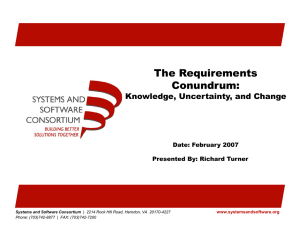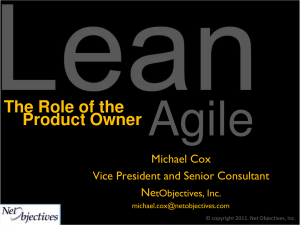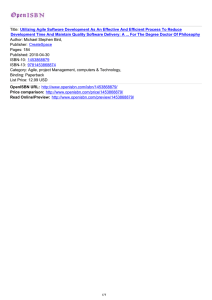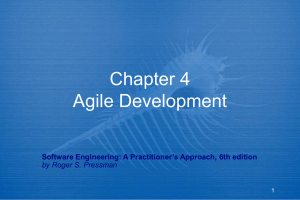Agile SAFe Coaching for RBPS Teams: DoD, AC, Maturity
advertisement
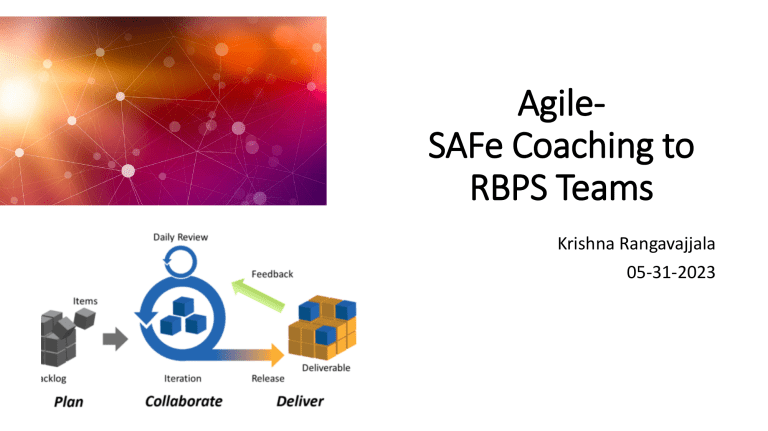
AgileSAFe Coaching to RBPS Teams Krishna Rangavajjala 05-31-2023 Agenda • Definition of Done (DoD) and Acceptance Criteria (AC) • Definition of Ready (DoR) - Optional • Agile Mindset • Agile Maturity • Metrics • Q&A and Next Steps Sample Footer Text 2 What has been Covered so far Objectives Technical Agility Built-in Quality Built-in Quality Metrics Business Agility Relationship among the above three Business Agility Metrics 3 Definition of Done (DoD) and Acceptance Criteria (AC) Definition of Done (DoD) and Acceptance Criteria (AC) What is the Difference? Definition of Done (DoD) outlines the quality standards that apply to the entire project or product be considered complete and ready for release. Examples: - DoD is a living document. - Review and update regularly. - DoD defines the minimum standards that must be met for a user story to be considered complete. - Varies depending on project, team, and stakeholders' needs. - Code is unit tested, integrated, and reviewed before merging - Approved by product owner - Automated tests and Manual testing passed - User documentation written and reviewed AC defines the specific requirements that must be met for the user story or feature to be accepted by the product owner Examples: - Acceptance Criteria should be SMART (specific, measurable, achievable, relevant, and time-bound) - Prioritize Acceptance Criteria - AC should be testable for verification of requirements Examples - User Story • "As a user, I want to be able to log in to the system using my email and password." • Let us try as a team to come up with DoD and AC for this. DoD and AC for the example User Story DoD: All code is written and checked into version control Code is reviewed by at least one other developer Automated tests have passed Manual testing has been completed and passed Documentation is complete and up-to-date The user interface is intuitive and easy to use These criteria defines the minimum standards that must be met for the user story to be considered complete. AC for the example User Story Notes: AC: The system validates the user's email and password The user can enter their email and password on the login screen The user is notified if their email or password is incorrect The user is directed to the home screen upon successful login • DoD sets minimum standards for user stories to be complete • AC specifies requirements for user story acceptance by product owner (PO needs to immediately if US does not meet AC) • DoD applies to all user stories and features • AC is specific to each user story. Another User Story • "As a frequent traveler, I want to be able to easily book a flight on my mobile device, so I can quickly plan my travel without having to use a desktop computer." • Let us try as a team to come up with AC only for this. Acceptance Criteria (AC) for the example User Story The user can search for flights using the mobile device. The user can view available flights with details such as departure and arrival times, number of stops, and price. The user can select a flight and view the seat map. The user can choose a seat and add it to their reservation. The user can enter their personal information, such as name and contact details. The user can enter their payment information, such as credit card details, and complete the booking. The booking confirmation page is displayed with the flight details and a confirmation number. The user receives an email confirmation with the booking details and confirmation number. Benefits of an Agile Mindset & How to Instill Agile Mindset in Teams Benefits of an Agile Mindset An Agile mindset and technical agility, enable an organization to create a steady, predictable flow of value delivery to the customer - the ultimate goal of the Scaled Agile Framework. Can lead to faster and more efficient delivery of quality products or services Improved business agility Reduced risk and increased innovation Improves communication and collaboration between team members, stakeholders and customers. Puts the customer at the center of the development process, resulting in higher customer satisfaction and loyalty. Instilling Agile mindset in Teams: Educate the team on Agile methodologies and their benefits Establish clear goals and priorities and empower the teams Encourage collaboration and teamwork Promote continuous improvement, experimentation, celebrating successes and learning from failures Encourage feedback from customers, stakeholders, and team members Provide the right tools and resources, such as collaboration software and project management tools Lead by example, modeling an Agile mindset and encouraging the team to do the same Recognize and reward Agile behavior to reinforce the Agile mindset Instilling an Agile mindset is an ongoing process that requires commitment and dedication from everyone involved. Challenges in Adopting Agile Mindset Common challenges when adopting an Agile mindset include: •Difficulty with team collaboration, •Lack of transparency •Resistance to change •Organizational structure •Lack of management support •Inadequate training and coaching •Misalignment of goals and incentives •Short-term focus •Scaling challenges •Cultural barriers •Silo mentality •Inconsistent implementation Agile Maturity Agile maturity represents the organization's level of understanding, application, and success in implementing Agile practices and principles. It encompasses the organization's ability to embrace change, deliver value incrementally, foster collaboration, and continuously improve. Agile Maturity is a set of practices and tools for improving agility Includes systemic improvements and agile thinking and practices Goals: faster decision-making, collaboration, customer value, productivity Benefits: reduced waste, customer-centric services, team efficiency Improves competitiveness and enables faster delivery of higher-value products Agile Maturity Indicators Examples of Agile Maturity Indicators: • Agile Mindset and Cultural Shift • Consistent and successful delivery of value to customers and stakeholders. • Efficient and effective Team collaboration and across cross-functional teams. • Frequent releases and shorter time-to-market for products or features. • Delivering value and quality to the customers • High levels of customer satisfaction and feedback. • Adaptive and flexible response to changing requirements and priorities. • Continuous learning Culture and knowledge sharing among team members. • Communities of Practice (Very Imp: Volunteer from RBPS team needed) • Proactive identification and resolution of impediments and bottlenecks. • Empowered teams that exhibit self-organization and autonomy. • Organizational Agility and Scalability and Agility at Scale • Strong leadership support and alignment with Agile values and principles • Measure and Grow Practices How do you Measure Agile Maturity Agile Maturity Index (AMI): • Formula: AMI = (Sum of agility factors maturity scores / Total number of agility factors) * 100 • Example: If an organization rates its agility factors on a scale of 1-5 and the sum of the maturity scores is 70 out of a maximum possible score of 100, the AMI would be (70 / 100) * 100 = 70%. To come up with the sum of agility factors maturity scores as per SAFe, you will need to assess the maturity of various agility factors within your organization. Let's say you have identified six agility factors (Leadership, Culture, Teams, Technical Practices, DevOps, Continuous Improvement) and assessed their maturity levels as follows: How do you Measure Agile Maturity • Leadership: Level 4 • Culture: Level 3 • Teams: Level 5 • Technical Practices: Level 2 • DevOps: Level 3 • Continuous Improvement: Level 4 • Sum of agility factors maturity scores for the organization = 4 + 3 + 5 + 2 + 3 + 4 = 21 Quiz • What is the purpose of Technical Agility? • How does Built-in Quality support Technical Agility in SAFe? • How does Agile Maturity impact an organization's ability to achieve Technical Agility and Business Agility in SAFe? • What are some key indicators of Agile Maturity ? • How does an Agile Mindset impact an organization's ability to achieve Agile Maturity in SAFe? • What is the relationship between Technical Agility and Business Agility? Funny Questions • Why did the Agile developer refuse to use a waterfall? • How many Agile developers does it take to change a light bulb? • Why did the Agile developer bring a ladder to the daily stand-up? • Why did the Agile developer go to the beach with the software tester? • Why did the Agile developer and the software tester go to the museum? Thank You Krishna Rangavajjala Rvnkrish@gmail.com Sample Footer Text 20
